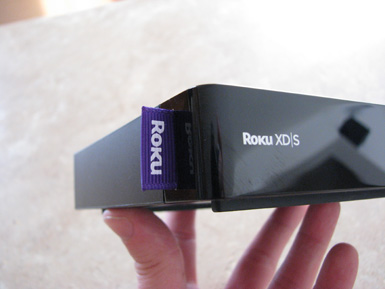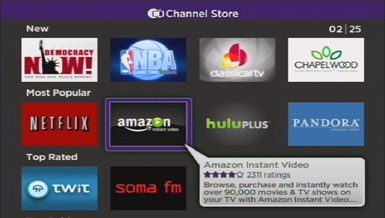
It may be hard to believe, but not long ago, Roku was only device that could stream TV shows and movies from Netflix. Unlike today, where just about every single device under the sun, from game consoles to mobile phones, help ensure that Netflix streaming accounts for a huge chunk of all web traffic.
Roku was the initial hardware partner for Netflix Instant Watch. Since their very first model, most people have always praised their easy-to-use, no frills approach. Last year when Apple launched their new Apple TV box at $99, interest in Roku’s players surged. Thanks to a little healthy competition, today you can get a Roku streamer starting at $60, with their most feature-packed model topping out at just $99.
Is the Roku XD|S the right streamer for you crazed TV addicts? I’ve gone hands on for for a whole month to find out just that. Read on!
THE GORY DETAILS
The box itself is smaller than I expected, measuring in at a hair under five inches across and back, and just a touch over an inch tall. It’s sports your typical black understated electronics look, which I personally prefer. The only unique design element is the distinctive purple tag with the Roku logo sticking out the side.
On the back, you’ll find composite video and analog audio jacks, HDMI, Ethernet, optical audio, component video mini-plug, and power ports. On the right side is a single USB port that lets you plug in and play audio, video, and photos from a USB flash drive or external hard disk. Inside is a dual-band 802.11n wireless networking chip, supporting both the 2.4Ghz and 5Ghz frequencies.

The remote is an equally simplistic twelve button affair, comfortable to hold and easy to use. All of the buttons are self-explanatory, except the star key, which serves as the button to call up the options menu for various elements.
The Roku, like many other devices these days, is a platform that supports development and expansion. Developers can build and support applications, called “Channels” here. These applications interact with web sites and other services to stream content (audio, video, and photos) to the Roku box. It even supports some simple games, believe it or not.
Roku has over 100 different channels at the moment, offering up both free and premium content. Roku pre-installs Netflix, Hulu Plus, Amazon, and the USB Channel, which are the primary services people are looking for. Inside the Channel Store is where you can browse and install the other Channels. All the major freebies are there: Pandora, Revision 3, TWiT, CNET, Vimeo, and Break, for example. Premium services include MLB.tv, NHL Game Center, and so on.

Blockbuster On Demand and Vudu were the only two absent that I really noticed… not that anyone else will.
NAVIGATION AND PERFORMANCE
The Roku interface is super simple. Across the home screen are your installed Channels. Left or right navigates through your Channels, OK selects one. Within the channel, you can browse and play whatever content it offers, be it music, video, photos or games.
Many channels may require you to log in to a service, like Hulu Plus or one of the sports networks. You’ll find typing in long e-mail addresses and passwords a bit painful after a while, but thankfully you only need to do each premium channel once.

Most channels I played with all performed amicably (the Hulu Plus app in particular was nice), but it can be a bit disorienting switching from Channel to Channel. Since each Channel App works a bit differently, so things like where to search for content and how to play items wildly differs. Fortunately, none of these apps are so complicated that you don’t figure it out after a minute or two.
The Roku XD|S does support limited playback capabilities from USB or external storage drives, although the codec support is pretty limited for video and audio. What it won’t do is stream from a local network storage device or PC out of the box. It also lacks any resemblance of DLNA, which means you simply can’t throw media at it from your phone or computer like you can do with an iPhone and Apple TV.
The Roku XD|S supports SD and HD video resolutions including 1080p, a selling feature Roku has over Apple TV. 1080p content, however, is still difficult to find. Netflix, Hulu, Amazon and most other sources stream at 720p. Image quality overall was excellent from top-tier providers and supported video files, particularly in HD. Of course, since a lot of content on the web doesn’t look good, image quality varies wildly with the source.
CONCLUSION
What started as a product solely designed to stream from Netflix has evolved into a platform that can deliver some of the best content on the web. I like to give credit where credit is due, and Roku deserves some accolades for being the first.
The Roku XD|S is the perfect solution for the type of person who loves to stream off the web, but doesn’t have a large local library of random video files. That’s a lot of people. It’s also great for anyone looking to add Netflix/Hulu/IPTV services to a secondary TV. It’s local playback capabilities aren’t useless by any means, but hardly enough to compete with the likes of companies like Netgear, Boxee, and Western Digital.
The set-top space is crowded with competition. Companies like Boxee and Apple have really made headway in this market over the last year, but Roku is just as good, if not better than many of their competitors on several fronts. As long as Roku continues to refine their product with new features (DLNA support would be a good start) and be a platform with online content people want to watch, a Roku streamer like the XD|S would be a good addition to just about every set in the home. Heck, at $99 a box, someone could even do just that.
I’ve enjoyed my time with the Roku XD|S. If you’re looking for a way to get the online content and services you love to your TV screen, you’ll enjoy it, too.
Satisfy your inner geek while fueling your TV addiction… TV Tech Fix is a column by Matt Whitlock, editor of the TechLore.com Consumer Electronics Community (plus several other gadget-focused community websites), and lover of both technology and TV. In this column, he’ll cover a wide variety of tech topics aimed squarely at the TV addicts of the world – from tips and tricks to help you better your TV experience, to gear recommendations, to the impact technology is having on the TV shows we love.